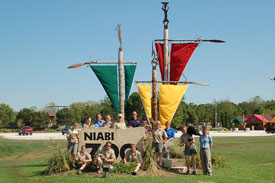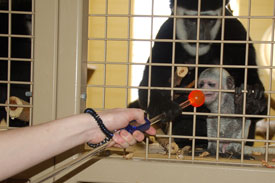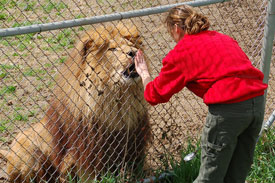Happy crossroads
The spring of 2008 was one of those times in my professional career when two wonderful opportunities merged into one. I was a few months away from completing the Karen Pryor Academy (KPA) Dog Trainer Program, honing my skills as a clicker trainer to help both animals and people. Just as my hard work began to come to fruition, and as I was about to graduate from the course, I received an e-mail from Niabi Zoological Society asking if I wanted to be considered as an applicant for their recently available Animal Training & Behavior Consultant post.
The previous Consultant is a dear friend and colleague of mine. I met Meg Hudson Dye in 1991 while we were both marine mammal trainers with the John G. Shedd Aquarium in Chicago. Her career path moved her toward exotic animal training consulting, which led her to Niabi Zoo. When Meg moved to North Carolina, she resigned her position with Niabi Zoo to pursue other amazing opportunities (one as the training consultant for Duke University’s Lemur Program). Why is this relevant? As a result of the amazing groundwork that Meg began with Niabi Zoo, I joined a team of proactive and positive trainers, a team that already had great learning experiences with Meg. My thoughts went from, “Wow, this is such a treat to be Meg’s successor!” to “Wow…I have some big shoes to fill!”
Niabi and new goals
Like Meg I also brought experience as an exotic animal trainer to my new position with Niabi Zoo. Niabi Zoological Society is a small AZA-accredited (Association of Zoos & Aquariums, www.aza.org) zoo that houses and cares for hundreds of species of animals. The zoo is located in Coal Valley, Illinois, near Western Illinois University.
Accepting the position at the zoo created the ideal opportunity to use the knowledge I gained through the KPA program. My job was to supplement the shaping plans and goals for the various species at the Niabi Zoo; our immediate goal at the zoo was to begin to formalize training plans that introduced the clicker as the bridge or event marker.
At Niabi, the goals of the training and behavior program, in addition to excellent animal care, are to provide mental stimulation, physical exercise, and cooperative veterinary care. Our team identifies specific goals for each animal area. We are flexible, we modify plans as needed, and we always focus on what is in the best interest of the animals.
Enjoy this video of one of Niabi Zoo’s female giraffes, Twigga (who is due to give birth very soon!). As this video was filmed, there were other giraffes being trained/clicked in areas that cannot be seen on the video. Be prepared to hear random clicks that are not intended for Twigga. In the video, Twigga is standing, voluntarily, in the chute on a scale. The trainer goals for a session like this are simple but critical: stationing, attention to trainer, name recognition, targeting (hand, buoy, and props/syringe), relaxed response to trainer Colleen creating distractions (moving back and forth to vet box, opening and closing the shift gates), targeting on a syringe (for future medication administration), neck tactile, calm separation from herd, and offering voluntary weights. Colleen uses selective reinforcement for voluntary neck tactile. She does not bridge/mark Twigga for backing away, but for calm tactile in a relaxation position. |
We started the formal clicker training program with specific animal groups. Initially, we planned to begin with the reticulated giraffes, the primates (cotton-top tamarins, black and white colobus, and Gabriella’s crested gibbons), the lions and other large cats (Bengal tigers, cougars, leopards and jaguars), and the Arctic foxes.
Training new behaviors, such as paw exams, may take time on the front end, but the amount of time saved for the animal, trainer, staff, and veterinarians on the back end can’t be measured. It is easier to teach a lion to open its mouth for an oral exam on a visual or verbal cue than it is to schedule a full exam that requires anesthesia. Teaching a giraffe to follow a target through a chute for voluntary weigh-ins is more time-efficient than scheduling a veterinary exam. It can take weeks to plan and organize an animal physical. But if the animal is trained to cooperate in the health care process, the exam can be done in minutes. Besides, teaching these behaviors is fun for the trainers and for the animals!
Creating a team environment: it takes a village
Who does this fun training, and how do they make it work? A successful animal training program like the one at Niabi Zoo is built by a team of individuals that work together. Our team discusses current successes and areas that need more attention and focus. We try to have enough trainers in each area to make progress and move forward. Two-day training workshops are scheduled every other month. During the workshops, we play the “Training Game” without the animals (more on that below, see also Don’t Shoot the Dog, pages 52-58), review videotaped sessions with each trainer and animal group (looking for peer feedback and highlighting success points), and brainstorm new ideas. Change is good!
To help every animal area move forward, each area is assigned a Lead Trainer who helps with the daily organization of sessions and ensures that all sessions are recorded. Video also provides wonderful incentives for trainers to reinforce their work and to reinforce positive focus in each area.
Slow and steady communication
We are all familiar with the following scenario: running around like crazy to squeeze a 30-hour work day into 9 hours. We wear many hats that involve various responsibilities. Despite our hectic schedules, the animals in our care deserve undivided and focused attention during every interaction. Our colleagues also deserve the same respect; to be a great team, we must communicate to other trainers thoughtfully and professionally. At Niabi Zoo, we plan pre-session and post-session training team meet-ups in the animal areas every day. The Lead of each area is responsible for creating dialogue and training goals for each trainer and each animal prior to a session. This time surrounding a training session brings the trainers to a focused and relaxed teaching environment that benefits both them and the animals in their care.
Record-keeping
Methodical record-keeping is another essential element for successful training. At the zoo, each animal has its own binder detailing all facets of care. Listed below are examples of recorded data that help us achieve training goals:
- Animal’s natural history
- Nutrition requirements
- Medical history
- Breeding information
- Weight charts
- Behavioral charts

Giraffe following a target through
the chute and onto the scale
(Click here to enlarge)
Behavioral charts include:
- Animal species, name, gender, habitat
- Date and time of each training session, name of trainer(s), location of session, length of session, behaviors that were trained, special notes (hibernation cycles, diet changes, breeding activity, changes in weather)
- Primary trainer and secondary trainer(s)
- Shaping plans that detail the steps each trainer will take toward achieving the final desired behavior
- Shaping staircase templates
There are also dry-erase boards in each animal area detailing goals and assignments for each trainer.
Train the trainer
Niabi trainers practice “Three E’s” while learning about the animals we train:
- Enthusiasm
- Education
- Empathy for the animal
It’s best to practice clicker mechanics before going “live” with an actual moving, breathing, faster-than-a-split-second lion. The “Training Game” is a fun way to support and train animal trainers. Get a group of animal trainers in the same room to play, and it’s all laughs. Here's an example:
“Hey, let’s see if Julie can stand on one leg posing as a flamingo, with her tongue sticking out!” (This is a real example from a KPA Dog Trainer workshop with faculty member Julie Shaw.)
Kidding aside, an excellent animal trainer is an excellent people trainer, observer, listener, and communicator. Karen Pryor’s amazing new book Reaching the Animal Mind emphasizes this point. A section in Chapter 10 highlights “The Importance of Fun,” and the evolutionary reasons behind its importance. Seeking—the one word that expresses so eloquently why we train and how we learn.
The training game also helps to develop observation skills when it’s not possible to talk to the learner whose behavior is being captured or shaped. As trainers, we know how easy it is to watch an animal, all the while thinking, “Hey silly, all you have to do is sit in the chair in the middle of the room. It’s so obvious!” Actually, it is not that obvious—as trainers who have played the training game know. The game helps create empathy for the learner, whomever or whatever it is you are training.
During one workshop seminar at the Niabi Zoo, the colobus troop trainers brought to my attention the fact that Gobo, the adult male, was not stationing at the same location reliably. We met as a team to discuss these training observations and then I observed a colobus session. I discovered that Gobo had learned that he could approach any trainer in any area and get clicked and reinforced. Later that day, I used the following scenario in the training game to help the trainers empathize with Gobo.

Laura, far right with a beautiful binturong
reaching over to climb on her,
with staff from the Niabi Zoo
(Click here to enlarge)
The team plays the new training game: Give me cash and I will return to the source!
One keeper volunteered to be the trainer and another, Jessica, volunteered to be the animal. We gated Jessica out of the room. I handed out lots of cash (okay…single dollar bills) to five other trainers, including the individual who had volunteered to be the primary trainer. I asked the five trainers to click and then reinforce the “animal” with money each and every time she walked toward them.
Keep in mind that Jessica was not in the room when I changed the training game rules to allow each trainer to reinforce her. Jessica only knew who her primary trainer was, and believed that her bridge and reinforcement came from only that one trainer.
What happened? Jessica entered the room and was cued by her trainer to begin the game. Jessica turned and walked a few feet away from the primary trainer (normal exploration); as she did so, she received a click and cash from a second trainer. The look on Jessica’s face was priceless. Her expression could be read as a mixture of “money!” and “Who is my trainer??” Jessica was cued by the second trainer to explore, only to hear a click and get cash from a third trainer. Jessica was now walking around the room in circles, heading toward each and every person, waiting to get a click and cash—she was quite confused! At that point the other trainers understood the lesson behind this game, and it was much easier to understand Gobo’s confusion about stationing in front of the “right” trainer.
It was a great game (yes, I did get all of my cash back). Better yet, Gobo is now stationing in front of his primary trainer reliably. After we played the game with his trainers, whenever Gobo wandered to other trainers he received no acknowledgement from them. The wandering behavior was extinguished. The solution was a wonderful team effort that stressed empathy and understanding for an animal that had been offering a behavior with a strong reinforcement history.
Clicking for care
Clicker training giraffes? Seriously?
Many zoos and aquariums use the clicker as a bridge or marker. Niabi Zoo is one of many amazing training programs that use the clicker to mark desired behaviors; the clicker becomes a conditioned reinforcer. Teaching exotic animals to cooperate in daily care creates a safe environment for the animals, the staff, and the zoo guests. Veterinarians are also included in the training process. We want the giraffes (and the other zoo animals) to learn that the presence of people mean positive outcomes.

Baby monkey exploring target
with mom training behind
(Click here to enlarge)
Why a clicker? The acoustics in many of the animal areas require a clear, concise, consistent, and easy-to-hear marker, and the clicker provides that. Niabi Zoo trainers use a box clicker or an i-Click. Whistles are also used as markers.
The clicker is simple, supporting the saying “less is more.” That’s an especially important statement when training an animal. It’s a mistake when trainers go for broke and attempt to train complex and advanced skills for which the animals, and the trainers themselves, are not ready.
There is nothing more wonderful than an animal that voluntarily moves from one habitat to another—just sweet and simple movement. This cooperation is wonderfully helpful for a keeper who cannot leave an animal outside overnight when a major storm is expected. Or for a keeper who has to access a habitat for immediate repairs. Teaching a lion or tiger to come calmly to a station for some high-value primary reinforcers, while another trainer closes a shift gate, is pure joy.
The best is yet to come—learn more in Part Two!
Click here for Part Two of Laura Monaco Torelli’s description of training at Niabi Zoo. In Part Two, Laura describes the five foundation behaviors from the KPA Dog Trainer Program, and how they are used at Niabi Zoo. She also talks about the exciting use of TAGteaching at the zoo.
Photos and video courtesy of Laura Monaco Torelli, Niabi Zoological Society




Post new comment